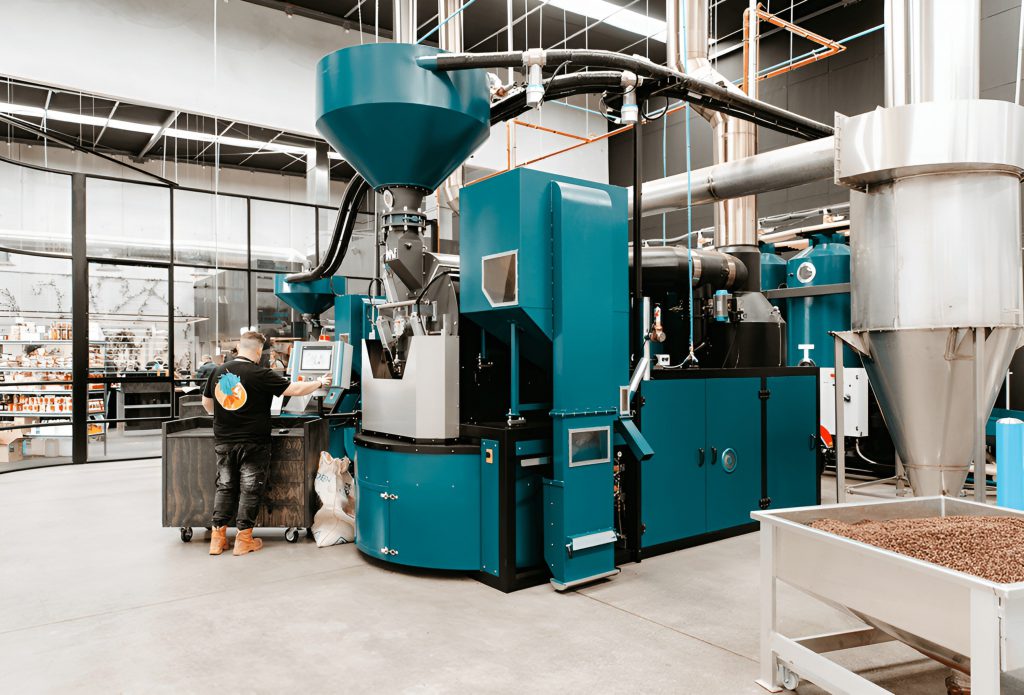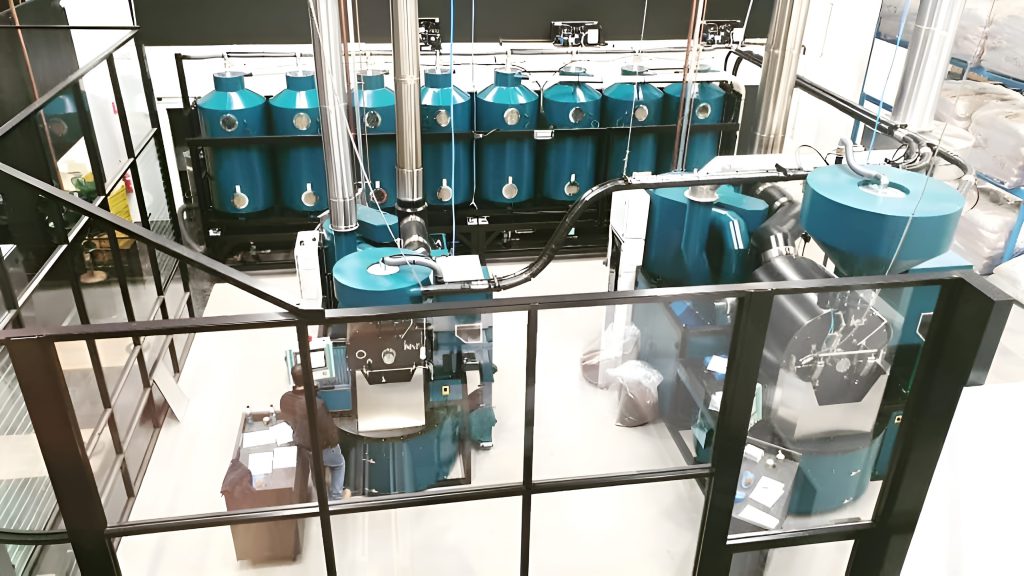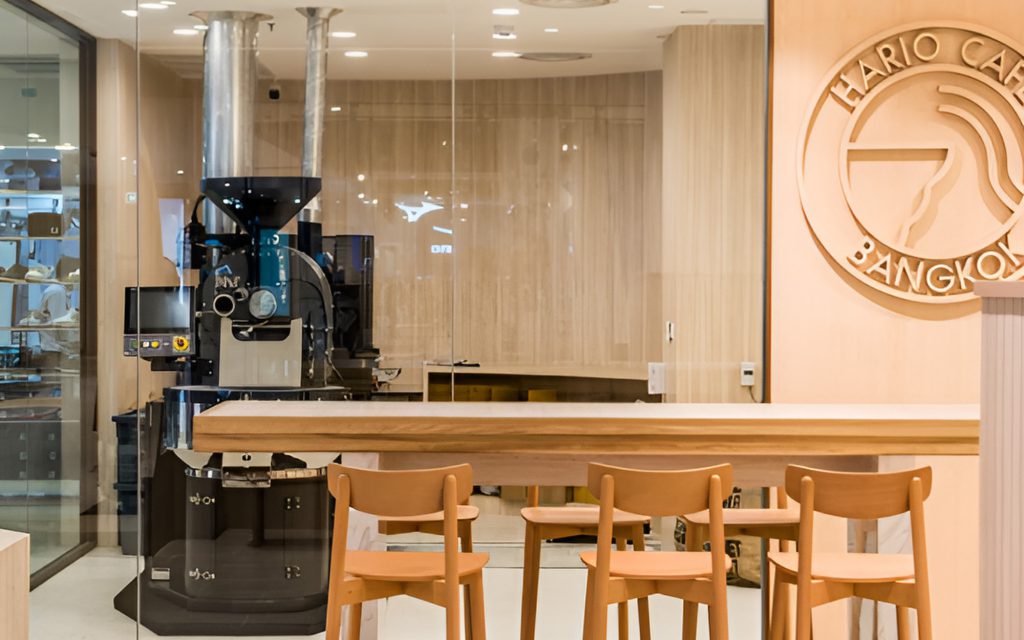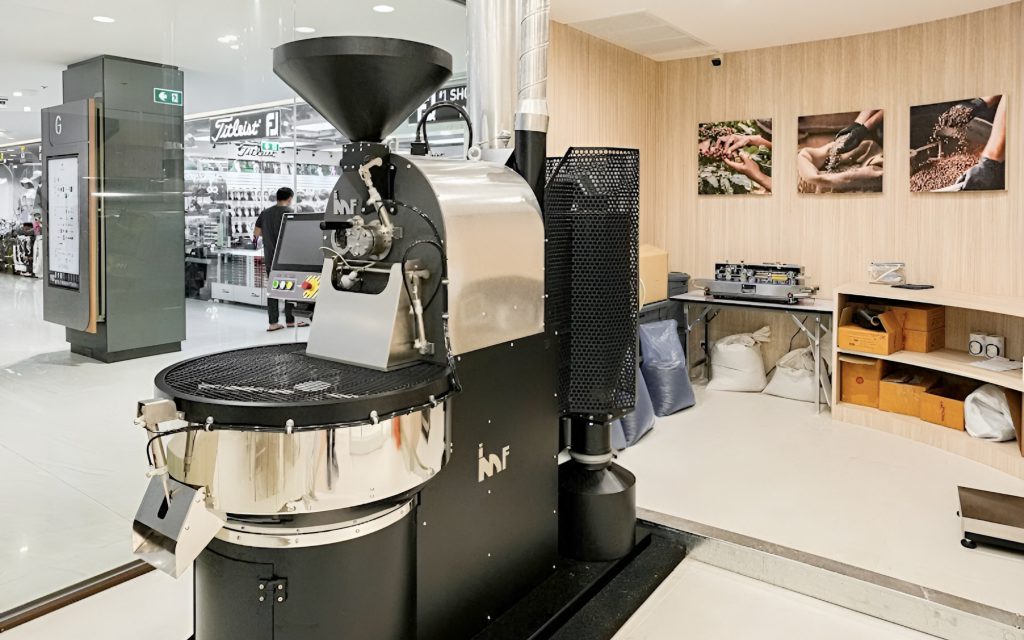How can you reduce emissions during coffee roasting?
In recent years, it’s become increasingly important for roasters to focus on sustainability – in terms of sourcing traceable and ethical coffee, as well as their environmental impact.
Although the coffee industry’s sustainability efforts tend to focus more on production and coffee shops, it’s also important that we consider other aspects of the supply chain, including roasting.
In line with this, more and more roasters are working to reduce their emissions, as well as their costs, by investing in more efficient and sustainable machines.
To find out more, I spoke with Production Engineer at roaster manufacturer IMF, Lorenzo Mosca, and Australian Sales Manager at IMF, Will Notaras. Read on to learn more about how you can reduce emissions during roasting, and why it’s so important.
You may also like our article exploring the environmental impact of coffee roasting.

Sustainability issues in coffee roasting
As with any other area of the coffee supply chain, there are a number of sustainability concerns about roasting.
Along with the production of smoke and other harmful particulates, arguably the biggest issues are carbon emissions and hazardous gases.
“During the roasting process, several gases are released into the atmosphere, including carbon dioxide, carbon monoxide, and nitrous oxide – as well as dust,” Lorenzo explains. “In larger quantities, these gases and particulates are harmful to human health and the environment.”
For coffee professionals who often work in close proximity to roasters, prolonged exposure to these gases and particulates can be dangerous. Moreover, carbon emissions are known to have a significant impact on global warming.
“Ultimately, this means machines need to include emissions reduction systems,” Lorenzo adds.
Now more than ever, roasters from across the sector have been monitoring their emissions levels, as well as looking for ways to reduce them. However, in order to do so, roasters need access to specialist equipment.
“You can test emissions from roasters using a flue gas analyser,” Will tells me.
“However, roasters should also seek the assistance of expert analysts who use specialist equipment,” Lorenzo says. “In fact, some roasters are obliged to carry out these tests based on laws in their respective countries.”
As a result of the growing need for reduce emissions during roasting, more and more roaster manufacturers are integrating efficient and sustainable technologies into their machines.

Why do roasters need to reduce their emissions?
With the effects of climate change becoming increasingly prevalent, it’s essential that roasters look for ways to reduce their carbon footprint. Research shows that global warming is having a significant impact on coffee production: experts predict that up to 50% of the world’s suitable coffee-growing land could decrease in size and suitability by 2050.
“Reducing your emissions means your carbon footprint is lower, which is much better for the environment,” Will explains. “It can also reduce your gas consumption, therefore your energy bills could decrease, too.”
As a result of the ongoing energy crisis, many coffee shops and roasters around the world are dealing with high gas and electricity prices. Ultimately, investing in more efficient and sustainable machines could help to keep these costs down.
Some newer and more modern roasters include energy-efficient technologies, such as heat recirculation systems, for instance.
“At IMF, we invest in research to develop innovative sustainable technologies,” Lorenzo says. “One example is the heat recirculation system, which recycles clean hot air using a dual function heating chamber.”
Will explains how this technology works:
“The machine uses a single burner to simultaneously incinerate emissions and create the heat source to roast the beans, resulting in lower emissions and reduced gas consumption,” he says.
“This technology is able to generate energy used in the roasting process and reduce emissions at the same time, thereby reducing energy and production costs,” Lorenzo tells me.
Furthermore, as sustainability becomes more and more important to coffee consumers, roasters need to take this into account in order to remain competitive.
“For roasters, there are several benefits to using more environmentally-friendly machines and equipment,” Lorenzo says. “For example, it shows customers that they are committed to reducing their environmental impact, which is especially important to younger generations.”
In fact, research has shown that Gen Z consumers are willing to spend up to 10% more on sustainable products – including coffee. Moreover, along with millennials, Gen Z consumers are much more likely to prioritise social and environmental factors as part of their purchasing decisions.
“Ultimately, investing in more efficient and environmentally-friendly machines means that you are adopting more sustainable business practices,” Lorenzo adds.

How can roasters reduce their emissions?
There are several ways to cut down on emissions during roasting, but one of the most notable methods is to invest in a more sustainable machine.
“More traditional and older roasters use a burner to create heat to roast the beans, and then use a separate burner (or afterburner) to incinerate the emissions,” Will tells me. “However, the afterburner releases higher levels of greenhouse gases into the atmosphere.
“This is because it uses higher volumes of gas than the machine needs to roast the beans, as well as the high temperature which is required to incinerate the emissions,” he adds. “IMF roasters only use one burner to carry out both functions, which in turn reduces gas consumption and emissions.”
Will explains that when investing in a new machine, roasters should look out for a number of key features.
“Heat recirculation technology is essential to reduce gas consumption and lower emissions,” he says. “As well as this, we use a patented vortex and equaliser system which allows for more consistent roast profiles.”
However, for smaller roasters, paying the upfront cost to purchase a new machine could be a challenge. Moreover, switching from a more traditional roaster to a newer machine could have a big impact on roast profiles – forcing roasters to significantly change how they roast their coffee.
Lorenzo explains that in these cases, roasters can instead invest in more efficient additional components for their machines
“There are options to upgrade your original machine so that you can lower its emissions,” he says. “This can include installing a number of different gas abatement systems, such as thermal or catalytic converters.”
Gas abatement systems help to change the chemical composition of gases, thereby effectively reducing or removing harmful emissions and air pollutants.
“Installing these systems means roasters can be in compliance with any emissions rules and regulations, as well as reducing their energy consumption,” Lorenzo adds.
He also explains other ways in which roasters can reduce their carbon footprint, which also includes adjusting their roast profiles.
“With more traditional machines, emission levels tend to be higher when you roast at higher temperatures or with darker roast profiles,” he says. “If you want to reduce your emissions, try reducing the roast temperature or total roast time, as well as roasting to more medium roast profiles.”
Furthermore, Lorenzo explains why ventilation systems are so important in making roasting more sustainable and efficient.
“More flexible ventilation systems make airflow management easier during the roasting process,” he tells me. “They reduce air volumes, especially in the final part of the process, which can help reduce the level of emissions released into the atmosphere.
“Roasters should also clean chimneys and ducts regularly to keep them free from oils and other particulates to reduce emissions,” he adds.
Ultimately, any roaster looking to minimise their emissions should start by reviewing their setup – and looking for any inefficient or underperforming equipment.

There’s no denying that the coffee industry’s focus on sustainability is going to become more and more prevalent in the years to come. As part of this, the need for roasters to invest in more energy-efficient machines is only going to increase.
However, alongside reducing their emissions, using more modern machines often means that roasters are also able to cut costs by improving energy efficiency – which is especially important at times like these.
Enjoyed this? Then read our article on how coffee roasters can design an appealing and efficient roasting space.
Photo credits: IMF
Perfect Daily Grind
Please note: IMF is a sponsor of Perfect Daily Grind.
Want to read more articles like this? Sign up for our newsletter!





